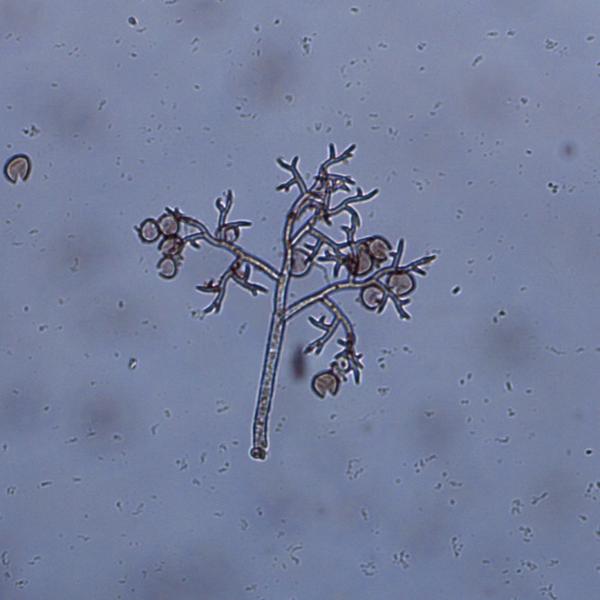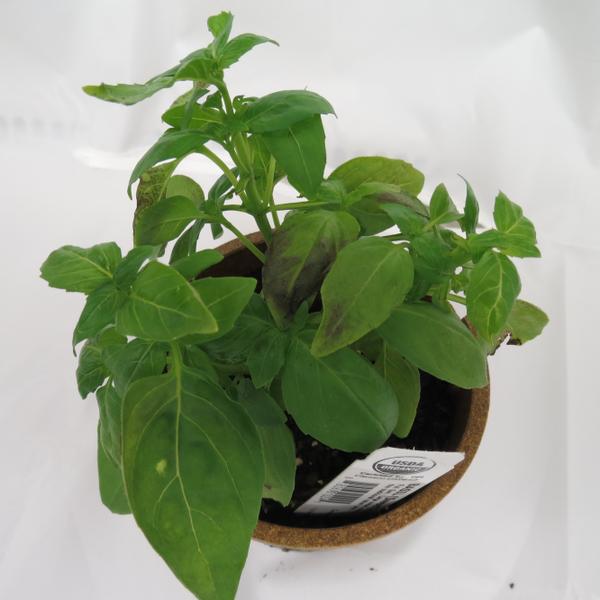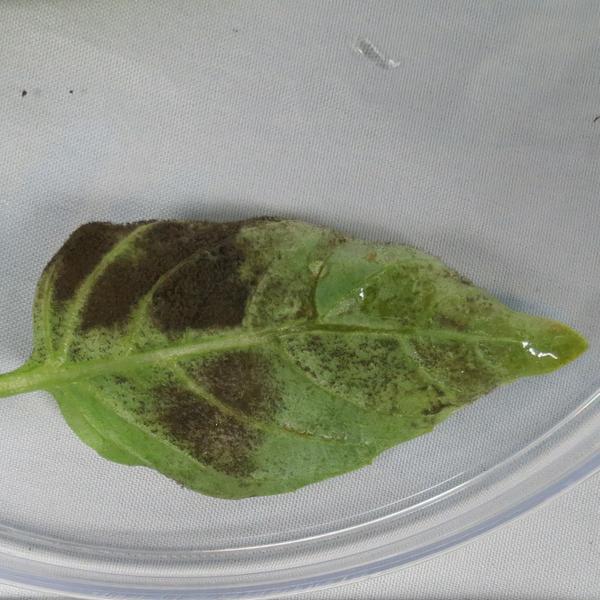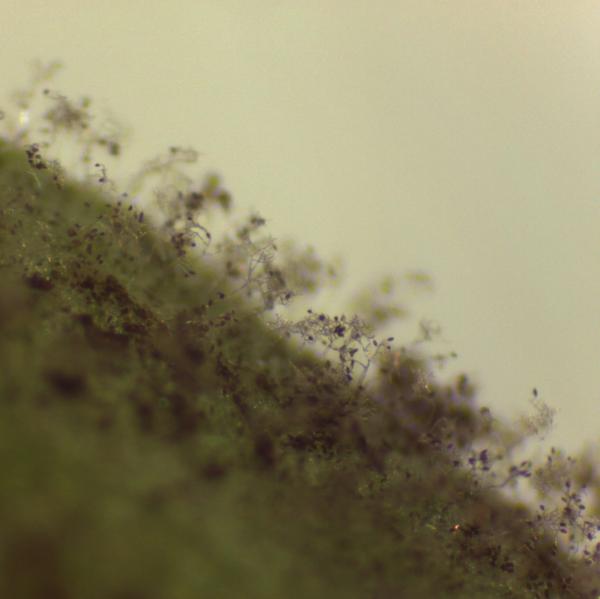Pathogen
Basil downy mildew is caused by the fungus-like oomycete pathogen Peronospora belbahrii (P. belbahrii) (Figure 1).
Host Crops and Plants
Basil.
Host Parts Affected
Leaves are severely affected, which can result in yield reduction or plant death.
Identification
Symptoms of the disease can be mistaken by nutritional problems since they manifest as a yellowing or browning of leaves (Figure 2). However, if the abaxial side of the leaf is inspected, profuse, dark sporulation will be covering the surface of infected leaves (Figure 3). Usually, the sporulation is obvious enough that it can be seen without a microscope or hand lens, however, when you take a closer look at the sporulation on the leaf with a hand lens or dissecting microscope, you will be able to see the typical sporangiophore structures bearing sporangia found in downy mildew pathogens (Figure 4).
Favorable Environmental Conditions for the Disease
- High-humidity and moisture (6-12 hours of moisture are ideal and usually occur as morning dew, rain or overhead irrigation).
- Cool temperatures (~60°F).
- In North Carolina, the disease typically begins in June and lasts throughout the growing season.
Disease Transmission
Pathogen spores can be transported from state to state through air currents. The pathogen needs a living host to survive and it can only overwinter on plants in sites with warm weather such as the Southern United States and greenhouses. Spores come to North Carolina every year from infected plants in surrounding states or in greenhouses with year-round production. The pathogen can also be seedborne.
General Disease Management
Peronospora belbahrii produces airborne spores and can also be seedborne, and like other oomycetes, such as Phytophthora and Pythium, this downy mildew pathogen thrives in humid conditions. Using pathogen-free seed is essential to prevent basil downy mildew and if the disease becomes established in your operation, consider removing infected plants to eliminate them as a source of inoculum. Reducing moisture by using drip irrigation vs. overhead irrigation, watering early in the mornings so foliage dries quickly, and allowing enough space between plants to increase air circulation will also help control this pathogen.
Be diligent in checking basil leaves for downy mildew.
Some varieties have been found to be less susceptible. Red basil (‘Red Leaf’ and ‘Red Rubin’), Thai basil (Queenette’), lemon basil (‘Lemon,’ ‘Lemon Mrs. Burns,’ ‘Sweet Dani Lemon Basil’), lime basil (‘Lime’), and spice basil (‘Spice,’ ‘Blue Spice,’ ‘Blue Spice Fil,’ ‘Cinnamon’), presented less severe downy mildew symptoms in a previous study.
Disease Control for Conventional Growers
Application of fungicides is the most effective strategy to control basil downy mildew. For the latest fungicide recommendations for basil downy mildew see the Southeastern US Vegetable Crop Handbook. Fungicide labels are legal documents, always read and follow fungicide labels.
Examples of products for basil downy mildew control:
| Active ingredient | Example product | Pre-harvest Interval (day) | Fungicide group |
| CyazofamidG | Ranman 3.6SC | 0 | 21 |
| Mandipropamid | Revus | 1 | 40 |
| Phosphorous acid | ProPhyt | 0 | 33 |
| G Can be used in greenhouses, see label for restrictions | |||
Regardless of the product, it is important to apply them in a way that you achieve good coverage on both sides of the foliage, and that you apply the products before disease begins. Fungicides are most effective when applied in a preventive, weekly spray program.
Sweet basil varieties resistant to downy mildew are now available and can be obtained via VDF Specialty Seeds:
Rutgers Obsession DMR
Rutgers Devotion DMR
Rutgers Passion DMR
Rutgers Thunderstruck
Disease Control for Organic Growers
Organic products including Actinovate (a. i. Streptomyces lydicus), Double Nickel 55 (a. i. Bacillus amyloliquefaciens), MilStop (a. i. potassium bicarbonate), Regalia (a. i. Reynoutria sachalinensis), Trilogy (a. i. neem oil), and OxiDate (a. i. hydrogen dioxide) are labeled for basil, however, efficacy data does not show high level of control with these products.
Disease Control for Home Gardeners
Products containing the active ingredients copper or chlorothalonil (the trade name of one product with chlorothalonil is known as ‘Daconil’) are the best and only effective products available to home gardeners. In addition, home gardeners should grow varieties with tolerance if they are worried about basil downy mildew in future years because most chemicals available to the home gardener are not sufficient to control basil downy mildew once it appears. Once plants are infected in a home garden, there is little that can be done to protect them besides weekly fungicide sprays.
Useful Resources
- The NC State Plant Disease and Insect Clinic provides diagnostics and control recommendations
- The Extension Plant Pathology Portal provides information on crop disease management
- The Southeastern US Vegetable Crop Handbook provides information on vegetable disease management
- The USDA Fungus-Host Distributions Database provides information about reported hosts for fungal and oomycete pathogens
Acknowledgements
This factsheet was prepared by the NC State Vegetable Pathology Lab in 2016.
Publication date: March 11, 2018
Reviewed/Revised: Jan. 9, 2023
Recommendations for the use of agricultural chemicals are included in this publication as a convenience to the reader. The use of brand names and any mention or listing of commercial products or services in this publication does not imply endorsement by NC State University or N.C. A&T State University nor discrimination against similar products or services not mentioned. Individuals who use agricultural chemicals are responsible for ensuring that the intended use complies with current regulations and conforms to the product label. Be sure to obtain current information about usage regulations and examine a current product label before applying any chemical. For assistance, contact your local N.C. Cooperative Extension county center.
N.C. Cooperative Extension prohibits discrimination and harassment regardless of age, color, disability, family and marital status, gender identity, national origin, political beliefs, race, religion, sex (including pregnancy), sexual orientation and veteran status.




